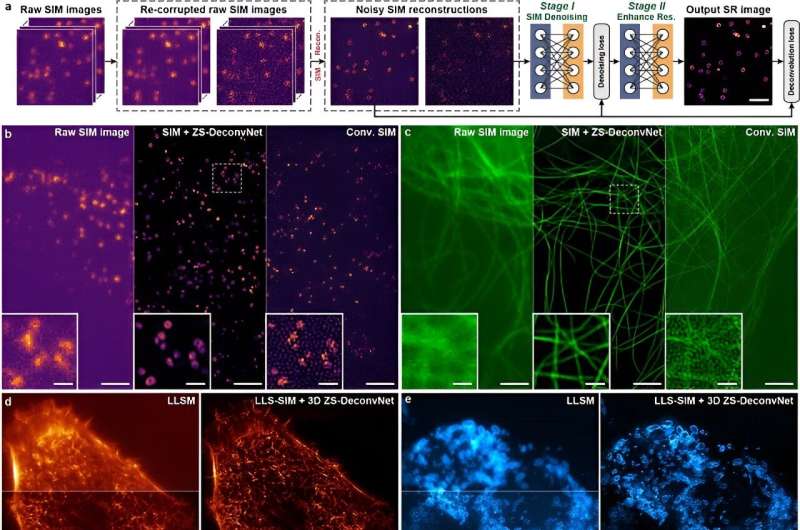This article has been reviewed according to Science X's editorial process and policies. Editors have highlighted the following attributes while ensuring the content's credibility:
fact-checked
peer-reviewed publication
trusted source
proofread
Scientists propose zero-shot universal microscopic image AI processing method

Based on the noise model of microscopic images and the zero-sample learning theory, researchers led by Prof. Li Dong from the Institute of Biophysics of the Chinese Academy of Sciences, in collaboration with Prof. Dai Qionghai's team from Tsinghua University, have proposed the zero-shot deconvolution networks (ZS-DeconvNet) and developed the corresponding one-click microscopic image processing software.
The study was published in Nature Communications.
ZS-DeconvNet can use only a single image with a low-resolution/noise ratio for training in an unsupervised manner, stably increasing the resolution of microscopic images to more than 1.5 times the diffraction limit at a fluorescence intensity working 10 times lower than traditional super-resolution imaging conditions.
The researchers designed a physics-inspired self-supervised loss function based on the photon noise model, the optical microscope imaging model, and the spatial continuity of the image. This function can learn denoising and super-resolution capabilities simultaneously without the need for additional training sets. And the researchers theoretically prove the convergence of the proposed loss function.
ZS-DeconvNet can handle various imaging modes, including total internal reflection microscopy, three-dimensional wide-field microscopy, lattice light-sheet microscopy, and confocal microscopy.
In particular, based on the theoretical discovery of the zero-noise expectation properties in structured illumination microscopy (SIM) image reconstruction, the researchers extended the proposed ZS-DeconvNet solution to SIM images, achieving the first unsupervised training of a noise-robust deep learning super-resolution model for SIM images.
ZS-DeconvNet can adapt to different biological imaging environments, even when biological processes are too dynamic and light-sensitive to obtain high-quality microscopic images.
Compared to traditional iterative optimization-based deconvolution methods, ZS-DeconvNet has shown significant improvements in qualitative and quantitative evaluations under all signal-to-noise ratio conditions, with data throughput increased by more than 100 times.
The researchers collaborated to develop a one-click universal Fiji plugin for microscopic image processing with integrated training and prediction functions, as well as a corresponding tutorial homepage, making it easy to use by life science researchers, even those not specialized in AI.
Finally, the researchers conducted extensive in vivo biological experiments to demonstrate the universality of ZS-DeconvNet. They found that ZS-DeconvNet can show excellent performance in various imaging modalities in biological experiments, thereby contributing to life science research.
More information: Chang Qiao et al, Zero-shot learning enables instant denoising and super-resolution in optical fluorescence microscopy, Nature Communications (2024). DOI: 10.1038/s41467-024-48575-9
Journal information: Nature Communications
Provided by Chinese Academy of Sciences



















